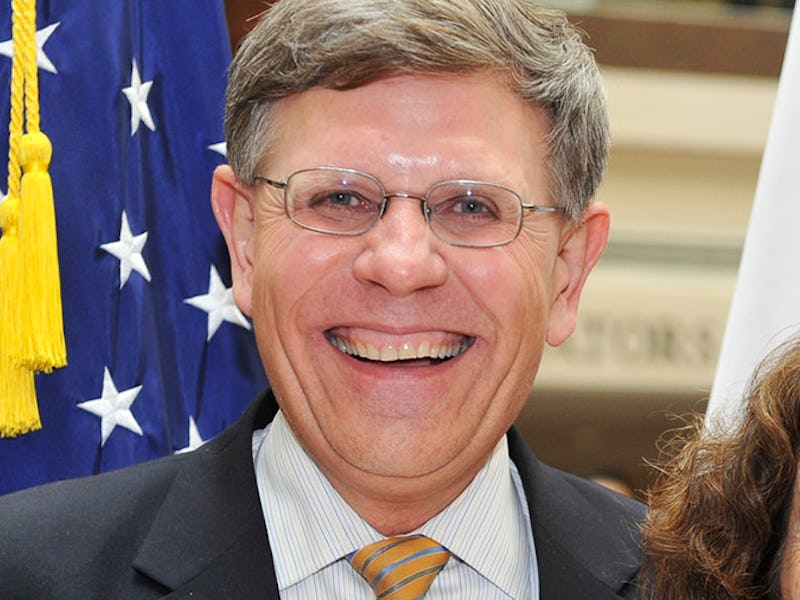4 Legitimate Scientific Contributions From Trump's Science Advisor Nominee
We need to talk about Kelvin.

On Wednesday, news broke that President Donald Trump will nominate Kelvin Droegemeier, Ph.D., to be the director of the federal Office of Science and Technology Policy. His official placement depends on whether or not he’s confirmed by the Senate, but if Droegemeier is approved, he’ll be the president’s chief adviser on science and fill in a post that’s been empty since the inauguration. He’d also be a very novel addition to the science-ambivalent administration: After all, Droegemeier seems like a pretty good scientist.
Droegemeier, a meteorologist, is currently Oklahoma’s Secretary of Science and Technology and vice president for research at the University of Oklahoma. He also served on the National Science Board under presidents George W. Bush and Barack Obama. His research has primarily focused on the dynamics and predictability of severe thunderstorms and tornadoes, making him an “extreme weather guy.” That said, as The New York Times notes, “his thoughts on climate change are not widely known.” Below are four things we do know about Droegemeier’s scientific chops.
Thunderstorms Prediction Technology
He's an expert in the study of thunderstorms.
In a video profile of Droegemeier made by the University of Oklahoma, he explains: “My own background in meteorology is to use computer models to understand thunderstorm dynamics and also to use this like radar data to assimilate them into models to see if we can actually predict thunderstorms in advance.”
This is work he’s been advancing for a while: In the ‘80s and 90’s he was one of the first to recognize that updates to technological tools like Doppler radar could make it easier to predict the formation of thunderstorms. He published a series of papers on the “numerical simulation of thunderstorm outflow dynamics,” referring to storm simulation data that could be plugged into computer models that predict when storms hit.
“Other people were saying thunderstorms are too random and unpredictable,” University of Oklahoma research scientist Keith Brewster, Ph.D., told the Times. “People were saying, you’re crazy for even trying this.”
The Collaborative Radar Acquisition Field Test
The project is described as a "public-private partnership."
Droegemeier initiated and led a national project called the Collaborative Radar Acquisition Field Test (CRAFT). The purpose of this project was to develop strategies for the delivery of NEXRAD Doppler weather radar data via the internet. The project used data drawn from 64 Radar Operation Centers across the country and was eventually adopted by the National Weather Service as the national model for monitoring storms.
According to the National Science Foundation, “This award-winning effort transformed the manner in which the National Weather Service provides time-critical radar data to industry, resulting in entirely new product lines and services for end users.”
Storm-Scale Numerical Weather Prediction
A tornado strikes Washburn, Illinois.
Droegemeier was the co-founder of the NSF’s Science and Technology Center for Analysis and Prediction of Storms (CAPS) and was the director of CAPS from 1994 until 2006. During his time with CAPS, he helped lead the research that bolstered the center’s reputation as one of most skilled centers in the world at storm-scale numerical weather prediction.
That’s because Droegemeier and fellow CAPS scientists developed the Advanced Regional Prediction System (ARPS), a comprehensive atmospheric modeling and prediction system that incorporates real-time data analysis, an assimilation system, a forward prediction model, and a post-analysis package. In a 2002 paper, Droegemeier and his co-authors announced that the ARPS successfully predicted a supercell storm that produced tornados more than eight hours in advance.
Storm Drones
Drones can be used to predict storms.
As part of his role as Oklahoma’s Secretary of Science and Technology, Droegemeier has supported and advocated for the use of drone technology as a way to detect severe weather, like tornados. He’s a part of the multi-university research team that received a $6 million grant from the NSF to develop unmanned aircraft systems, or drones, for the study of atmospheric physics. As of now, scientists can detect a tornado landing about 14 minutes before it hits. Using drones equipped with meteorological equipment, scientists think they could get a warning out within an hour.
“We want to take it [the drone] out in the pre-thunderstorm environment, prior to storms forming, to capture the antecedent conditions before the storm forms,” Droegemeier told Reuters in 2017. “That will give us an opportunity to understand how storms form and improve the forecasting of when and especially where thunderstorms form.”
That’s a pretty cool thing to be working on — although, if this nomination goes through, Droegemeier is going to be a busy guy. If he does become the director, his role will be to advise Trump — who thinks climate change is a “Chinese hoax” — on all matters of science.